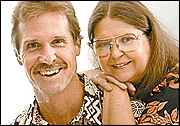Advertisement - Click to support our sponsors.


Health Options
EVERYONE has heard that staying physically active is good for your heart and your bones. Now research on aging Olympian athletes indicates exercise may be the key to the fountain of youth. Get physical to
ward off effects of ageAs people age, a number of physiological changes are commonly observed. A person's metabolic rate declines and therefore calorie needs decline. This leads to weight gain if the average amount of calories consumed doesn't decrease sufficiently. If a person decreases calorie intake but doesn't maintain adequate protein intake, total muscle can decrease even more.
Other commonly observed changes that occur with age include a decreased capacity for the heart to pump blood, decreases in muscle strength and total bone mineral, and an impaired immune system. Along with these changes, a decrease in the ability to perform exercise and other physical activities is observed.
Many would say (including many health professionals) that all of these functions decline, including being active, because they are just a natural consequence of aging. But which comes first, declining physical function with age or decreased physical activity? There is good evidence that decreasing physical activity causes the decline in physiological functions much more than getting older affects our activity level.
INTERESTING evidence for this comes from a study that measured physiological characteristics of 26 Olympic distance runners in the 1968 Olympics and remeasured them 25 years later. Those who were still running and maintaining their body weight had lost 15 percent of their maximal exercise capacity. Those who had stopped running declined by 36 percent. This indicates some effects of aging seem unavoidable, but one of the best ways to minimize them is to stay physically active.
If you have strayed away from physical activity, the good news is it's never too late to add it back to your lifestyle. However, pick it up very gradually and comfortably. It may have taken years to get out of shape, so it can certainly take months to get back into shape. The good news is studies show that even those in their 90s have the ability to add back muscle.
NO one else can tell you the best type of exercise for you. If it's not fun, you are unlikely to keep it up. However, if you have not exercised for some time, your physician and a good exercise trainer can give you guidelines on how hard you should exercise and how quickly or slowly to try to get back into it. The trick is to find activities you enjoy.
Certainly, physical activity can be more difficult for some people due to physical limitations or even a mental aversion to activity. Researchers have reported babies who move around more right after birth end up being more physically active later in life.
So, if you were born with a tendency to exercise, you are lucky. However, if your inclination is to "sit"more than "stand," you may need to use a bit of will power to get out the door. Remember, just doing enough brisk walking, gardening, climbing stairs, etc. to add up to 30 minutes a day can make a big difference.
The next time someone tells you slowing down is part of getting old, reply, "No, slowing down has made me feel older, but my new resolution is to move more. Check me out in a couple of months." Then get active.
Health Events
Joannie Dobbs, Ph.D., C.N.S., is a food and nutrition consultant
and owner of Exploring New Concepts, a nutritional consulting firm.
She is also responsible for the nutritional analyses
indicated by an asterisk in this section.Alan Titchenal, Ph.D., C.N.S., is a sports nutritionist in the
Department of Human Nutrition, Food and Animal Science,
University of Hawaii-Manoa.